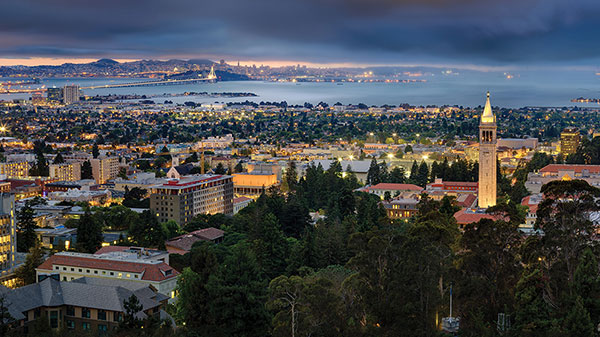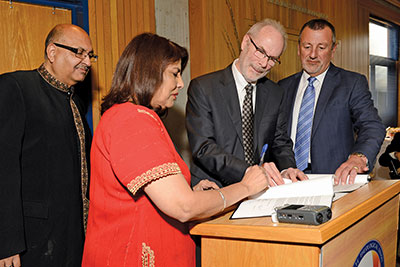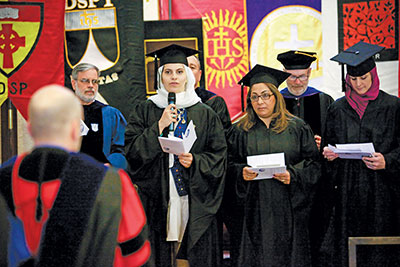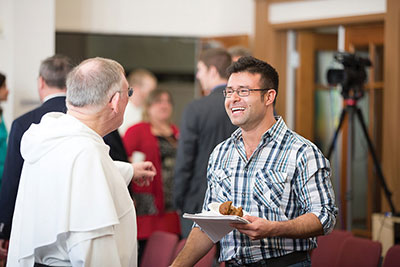 |
| Image Credit: Mike Oria |
The phone rang just as Susan Hoganson, chair of the board of the Graduate Theological Union (GTU) in Berkeley, California, was dashing out the door to a Palm Sunday service. It was one of her dearest friends, a Jewish woman with whom Hoganson has traveled the world.
During their brief conversation, Hoganson realized her highly educated friend, who was immersed in literature and art, had no idea what Palm Sunday was.
“I said, ‘I’ll have to explain it to you,’” she remembers. And that became another chapter in ongoing interfaith conversations Hoganson regularly has. “It’s more than learning about other religions,” she says. “It’s having the opportunity to talk with someone who practices a different faith and really understand what is important to them. And in some way it strengthens your own faith by understanding them.”
That is the kind of dialogue that is at the heart of the Graduate Theological Union, a consortium of eight theological schools and more than a dozen research centers representing a variety of traditions, including Jewish, Hindu, Islamic, and Buddhist, among others. The consortium and most of its individual schools occupy Holy Hill, a neighborhood just north of the University of California’s flagship campus in Berkeley.
A complex governance structure
The GTU board of directors, which Hoganson chairs, is the governance body that oversees the whole consortium. The board itself reflects GTU’s diversity: It’s made up of the president of each member school, plus GTU president Riess Potterveld. Each of the eight member schools also elects one representative member, who serves alongside two members of the core doctoral faculty (elected by their fellow faculty members), one doctoral student, and one master’s student. Up to 24 at-large board members round out the governing body.
But the overall governance is even more complex, because each member school has its own board of trustees, as do the affiliate organizations. The research centers have advisory councils. A Council of Presidents guides the GTU’s daily operations, meeting monthly. (Only the presidents of the member schools sit on the council, although the heads of the affiliates update the council on their activities and plans.)
Hal Leach, past chair of the board, believes that if GTU is going to thrive in an interreligious world, the whole board must embrace its vision and learn to see themselves as part of a pioneering effort.
It is the role of the board to initiate conversations about growth, risk, and new offerings, he says. “If you’re not moving forward, then you’re regressing. Boards need to continually push that.”
|
How do you fund a sprawling consortium?
All of the schools in the Graduate Theological Union (GTU) run annual fund campaigns, draw from their own endowments, and (of course) generate tuition and fees from students. Auxiliary income is generated by activities like rental property and continuing education programs.
But what about the consortium itself? GTU President Riess Potterveld explains: “Member schools are obligated to pay into the library, through a prescribed formula based on student credit hours, and a general allocation that helps underwrite the expense of running the GTU.” The GTU itself also pays into the library and is in fact the largest contributor, because GTU has the largest student enrollment. Moreover, GTU has its own annual fundraising and its own endowment of more than $40 million.
Individual member schools may also contract with the central GTU administration for services like accounting, financial aid, and informational technology. Fees for these services are arranged between the GTU business office and the school.
—Karen Stiller
|
Hoganson, who succeeded Leach as chair, agrees. She calls GTU a “powerhouse jewel that is sitting on the hills.” She says that one of the board’s frustrations is that “we have this little treasure, and we want more people in the community to know it’s there, to participate, to give money, to be aware.”
 |
The Mira and Ajay Shingal Center for Dharma Studies was established in 2015 with a $4.4 million gift from an entrepreneurial couple in San Jose, California. From left, Ajay Shingal, Mira Shingal, GTU President Riess Potterveld, and GTU board chair Harold Leach.
Image Credit: Dana Davis |
Hoganson says the largest challenge is making sure that the members of the board represent the diversity of the faiths that GTU serves. “We’ve been minimally successful at it,” she says. “I’d like to see us become even more successful. It’s something we are working at.”
Hoganson also says that the board is looking for potential members who are enthused by an interfaith board. “We are looking for the person who is excited by that, not the person who says ‘Oh gosh, I’m a life-long whatever and I’m only interested in that.’ That might be a good person for an individual school’s board, but not necessarily the GTU board.”
Strategic planning happens at multiple levels at the sprawling consortium. Each school and center does its own planning for its own governance, programs, and facilities, but joint offerings are planned and implemented at the consortium level. And that includes interfaith activities that are central to the GTU’s DNA.
These are exciting and perilous times, and GTU has plans not just to survive but to flourish. That means marshalling all the consortium’s assets to reach out to the Bay Area and the state in all their diversity.
Reaching a growing edge
Berkeley lies in Alameda County (population: 1.6 million), just across the Bay Bridge from San Francisco. The county’s 10 largest faith groups, in order, are Catholics, nondenominational Christians, Muslims, Mormons, Southern Baptists, members of the Assemblies of God, Mahayana Buddhists, Presbyterians, and Reform Jews. Countless smaller groups are represented as well. That’s GTU’s context.
“Hopefully there is sufficient interest in interreligious studies that we will regain our ability to attract students and to reach a stronger model going forward,” says Potterveld. From the beginning, GTU’s founders described it as interfaith, but in the consortium’s early years, that meant various kinds of Christians studying together. Moving beyond “interdenominational” to embrace multiple religions has been “a long time coming,” he says.
The administration is optimistic that enrollment will pick up as students are drawn by a vast banquet of courses — about 700 per year — that represent a multitude of faith traditions. And they hope that the opportunity to study alongside students of other faiths and learn from professors who actually practice those faiths (most faculty are fixed in a tradition) will be a growing edge that sets GTU ahead of the competition.
How are they recruiting those students? Each member school operates its own admissions office and recruits its own master’s-level seminarians; Potterveld says that the various admissions offices generally don’t compete for the same students. Furthermore, any student can take a course at any member institution, and cross-registration helps break down silos. If competition for students does exist, it is friendly, and all students are poured into the wide-open world of the GTU.
Interfaith collaboration
The consortium is trying to offer a healing example for troubled times. “We are living in a world where many religions are in conflict with each other,” says Potterveld, but at GTU, there’s a unique opportunity to examine what he calls persistent perplexing problems — and perhaps even to work on solutions. “What we’re slowly doing is developing the capacity to get all the religions to focus on some of these issues that are tearing cultures apart, the things that need to be resolved for us to have a more peaceful world.”
GTU’s seventh annual Islamophobia Conference was held last April. The conference, one of many regular events hosted by GTU’s Center for Islamic Studies, is an example of that center’s dual commitment to scholarship and service to the wider community.
The Center for Islamic Studies was established in 2007, and Munir Jiwa has been its director since the beginning and also teaches Islamic Studies. He says that the center “brings together academic study in an interreligious context where the practice of faith matters.” He adds: “A lot of what we do is outreach to other academic communities, but we also want non-academic communities to participate, whether its art communities or interfaith communities. They are all important for us to enlarge the conversation and see Islam as an American religion, which it is.”
The collaboration between GTU’s Center for Islamic Studies and the Richard S. Dinner Center for Jewish Studies is the poster child for how interfaith collaboration can play out on GTU’s campus and beyond.
In 2009, the two centers joined forces to offer the Madrasa-Midrasha program, which produces workshops, lectures, courses, and public events exploring “what is similar and what is different,” says Jiwa.
“As the two non-Christian centers at the time, we decided there was so much misunderstanding of both traditions and of each other’s traditions, and there wasn’t a lot of time and space to study them both together and learn something about Jews and Muslims,” he adds.
 |
From left to right, graduates Farah El-Sharif, Deenaz Kanji, and Sarah Heddon led the invocation at the Graduate Theological Union's 2014 commencement. Prayers from the Islamic tradition were offered in Arabic, Persian, Swahili, Gujarati, and English.
Image Credit: Joann Renee Photography |
The first public class held jointly by the two centers was filled to capacity, and they haven’t looked back. Since then, class topics have included “Media Representations of Jews and Muslims,” “Hagar in the Jewish and Islamic Traditions,” “Kosher and Halal,” and “Thinking about Gaza,” all examined by Jewish and Muslim scholars who study and practice their faiths together.
Revised doctoral programs play to GTU’s strengths
GTU is launching two doctorates with revised curriculum this fall — a Ph.D. and a Th.D. — that will provide further opportunities for interdisciplinary and interreligious studies.
President Potterveld says that four broad interdisciplinary categories will make up the new programs:
• Sacred texts and their interpretation
• Historical and cultural studies of religion
• Theology and ethics
• Religion and practice
Within those categories are more than 30 concentrations, such as rabbinic literature, Buddhist studies, Hindu theology, Islamic philosophy and theology, and homiletics. Organizers hope the new configuration of the program encourages more cross-disciplinary and interreligious study and dialogue.
 |
Mauricio Jose' Najarro at a 2014 meeting of the College of Fellows at the Dominican School of Philosophy and Theology.
Image courtesy the Dominican School of Philosophy and Theology |
Just enough challenge
Mauricio José Najarro is a current Ph.D. student. He’s a Catholic, with family roots in the rich soil of liberation theology in El Salvador, and teaches courses at the infamous San Quentin prison, including a class on religious literacy.
Najarro’s own faith, and how he presents other faiths to his students in prison, has been deeply shaped by his time at GTU. “I can be at that table and have a better sense of who I am, because I’m not who they are,” he says. “We can ask these questions and I can feel my Catholicism when I give my answers. The richness of the discussion is really important.”
Najarro also appreciates that GTU fosters scholarship from many angles. “People are able to do research that doesn’t get done in other places.” He cites Munir Jiwa’s work on Muslims in the media as a top example.
Is GTU, with its interfaith reality the star of the show, a good fit for every seminary student?
Probably not, says Najarro. “You want to be challenged, but it can’t be 100 percent challenged or it won’t work. And it can’t be 100 percent home or you won’t ever be challenged.” But nevertheless, he thinks that GTU’s interfaith mix is great. “It’s definitely the way I think religious and theological conversations are going and should go.”
Karen Stiller is a freelance writer in Port Perry, Ontario. She is senior editor of Faith Today magazine.
| GTU Member Schools |
| American Baptist Seminary of the West |
American Baptist Churches |
| Church Divinity School of the Pacific |
Episcopal Church |
| Dominican School of Philosophy and Theology |
Roman Catholic |
| Jesuit School of Theology at Santa Clara University |
Roman Catholic |
| Pacific Lutheran Theological Seminary |
Evangelical Lutheran Church in America |
| Pacific School of Religion |
United Church of Christ with historic ties to United Methodist Church and Disciples of Christ |
| San Francisco Theological Seminary |
Presbyterian Church (USA) |
| Starr King School for the Ministry |
Unitarian Universalist |
| GTU Centers |
| The Asia Project offers courses on Asian religions, cultures, and theologies. |
The Center for Theology and the Natural Sciences, incorporated as a nonprofit in 1982, promotes dialogue between religion and science. |
| The Black Church/Africana Religious Studies Program offers a certificate program for students enrolled at GTU or its member schools. |
The Institute of Buddhist Studies, an affiliate of GTU since 1985, is associated with the Buddhist Churches of America and offers a master’s degree in Buddhist studies jointly with GTU. |
| The Center for the Arts, Religion, and Education promotes scholarship, reflection, and practice in the arts and religion. |
New College Berkeley, an evangelical institution affiliated with GTU since 1992, offers a year-round program of continuing education and seminars in topics like “faith and daily life,” “faith and science,” and “faith and geopolitics.” |
| The Mira and Ajay Shingal Center for Dharma Studies supports scholars and students studying Hindu and Jain philosophy and religion. |
The Patriarch Athenagoras Orthodox Institute, a “patriarchal institute” under the Ecumenical Patriarchate of Constantinople, offers lectures and other educational programs and co-sponsors (with GTU) a master’s in Orthodox Christian studies. |
| The Center for Islamic Studies provides graduate courses in Islamic history, theology, philosophy, culture, arts, and religious practice. |
The School of Applied Theology was founded in 1960 as the Institute of Lay Theology to train lay leaders for the Catholic church. Today the school provides sabbatical and spiritual renewal programs for Catholic religious leaders and lay people of all traditions. |
| The Richard S. Dinner Center for Jewish Studies offers programs for Jewish students planning careers in Jewish studies or Jewish education and provides for exchanges between Jewish and non-Jewish scholars. |
Women’s Studies in Religion Program offers programs and a certificate in women’s studies in religion for graduate students at GTU and its member schools.
|
| The Center for Swedenborgian Studies was an independent seminary from 1866 until 2001, when it became a house of studies at Pacific School of Religion. In 2015, it affiliated with GTU, where it offers courses in theology, the arts, spirituality, history, and biblical studies. The center is the official seminary of the Swedenborgian Church of North America. |